Charles E W Bean, Diaries, AWM38 3DRL 606/116/1 - June - September 1918 - Part 12
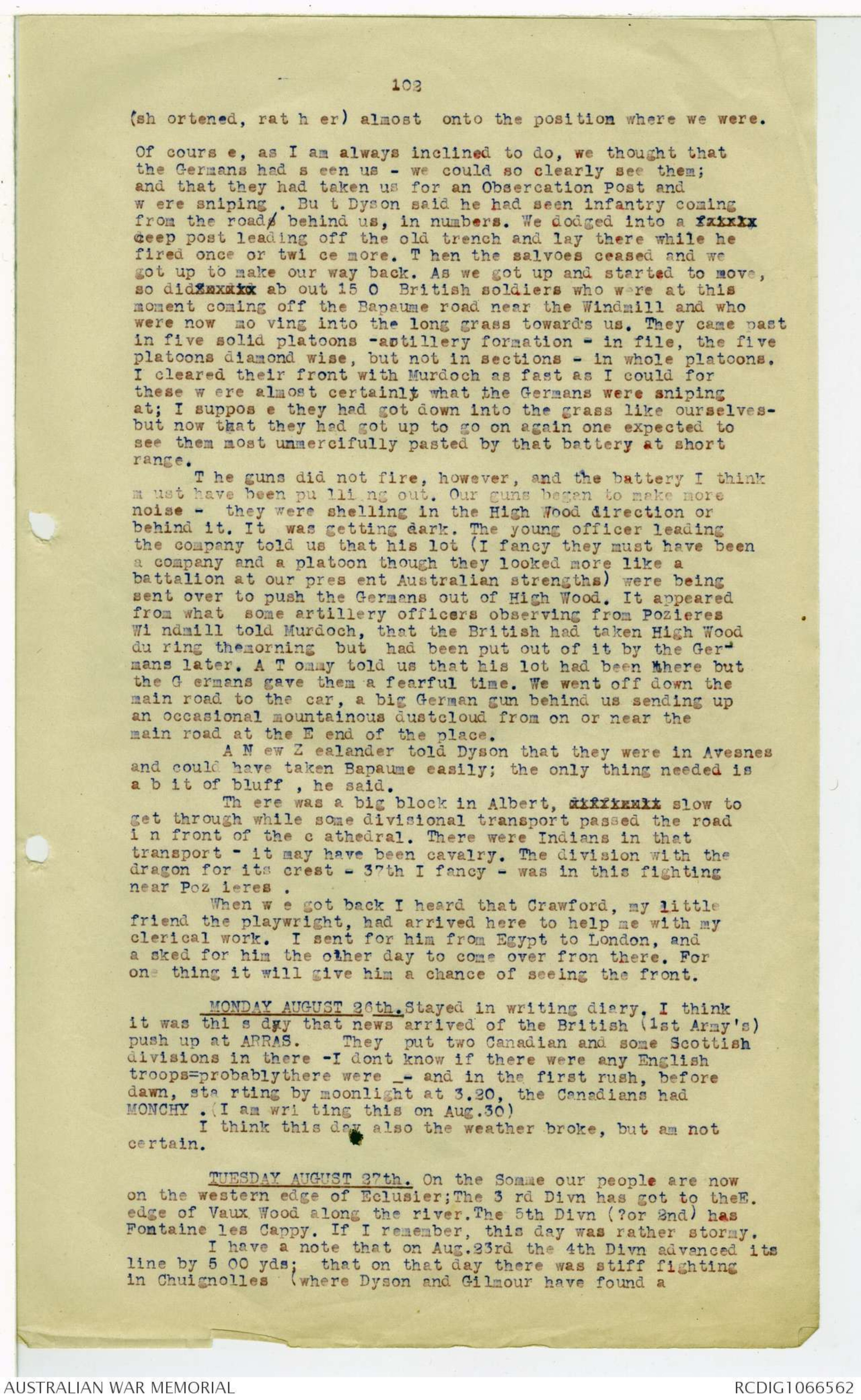
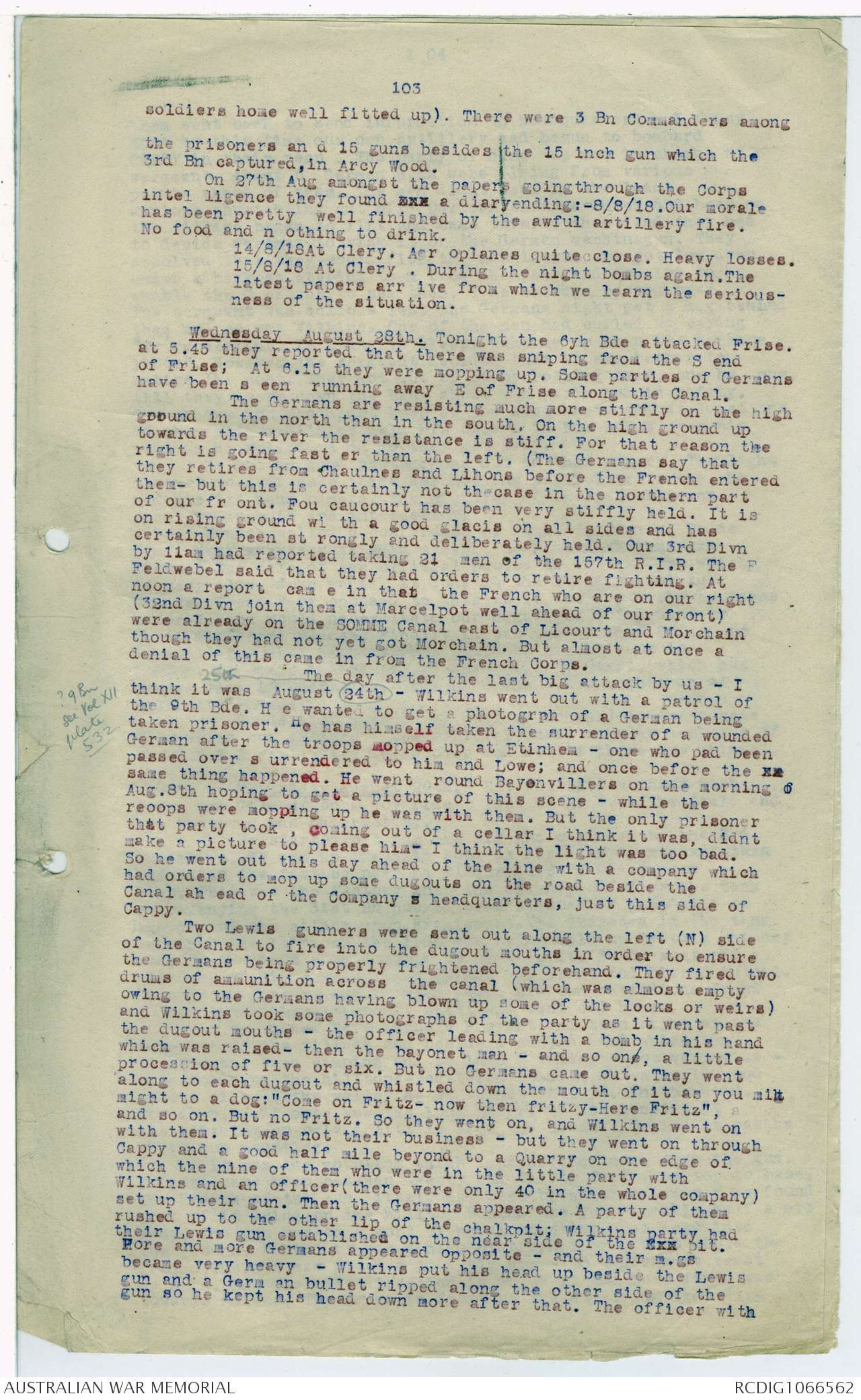
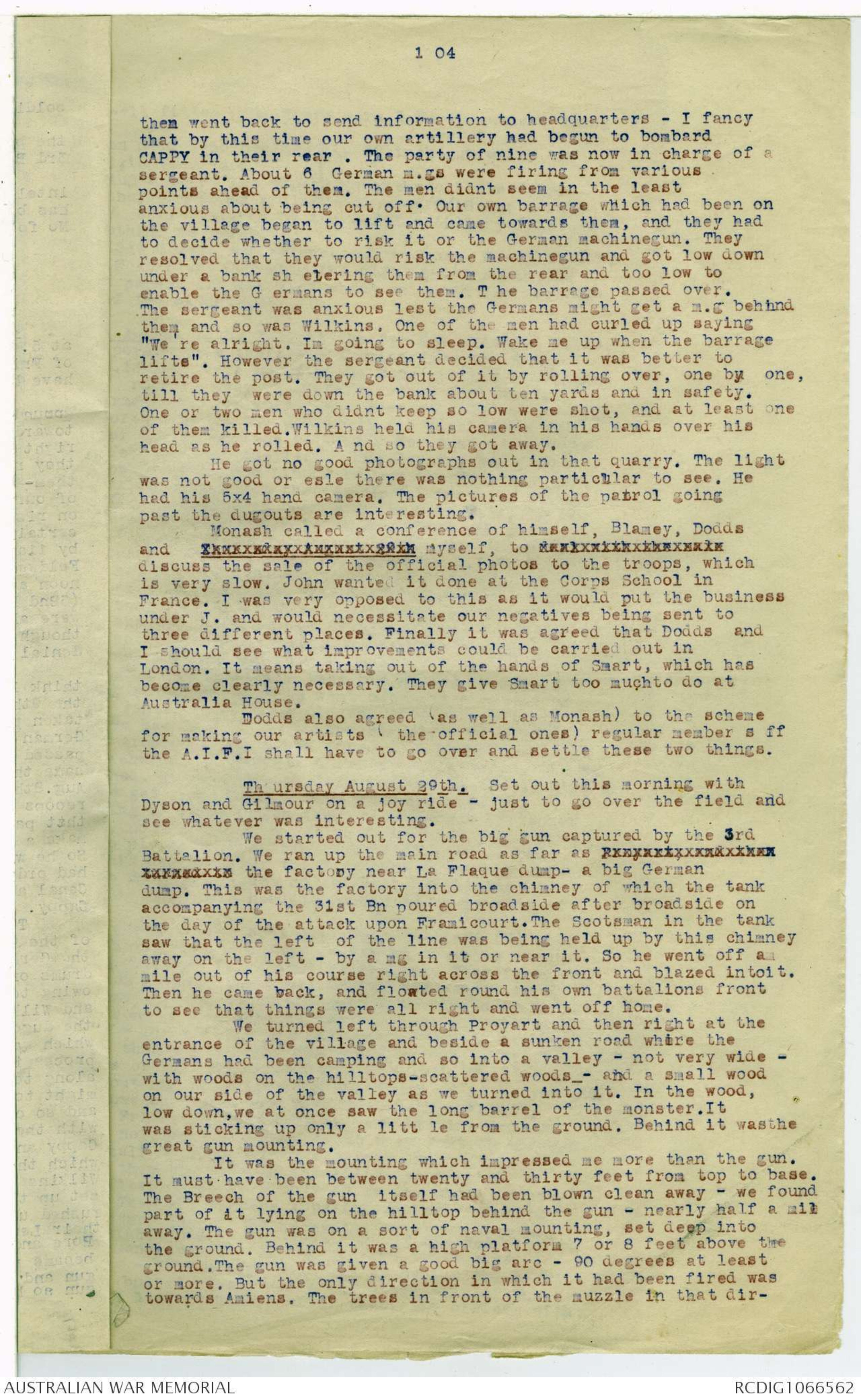
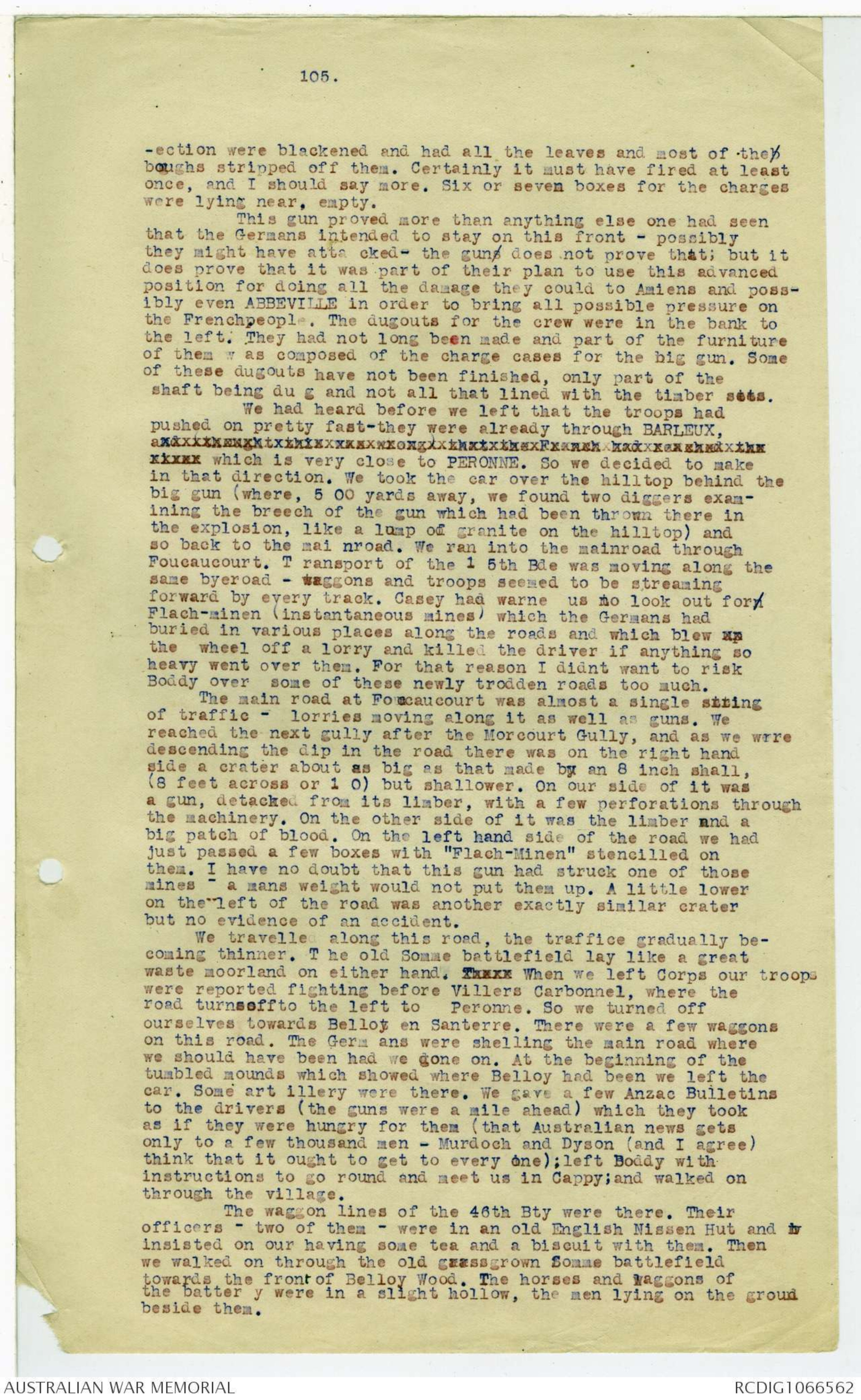
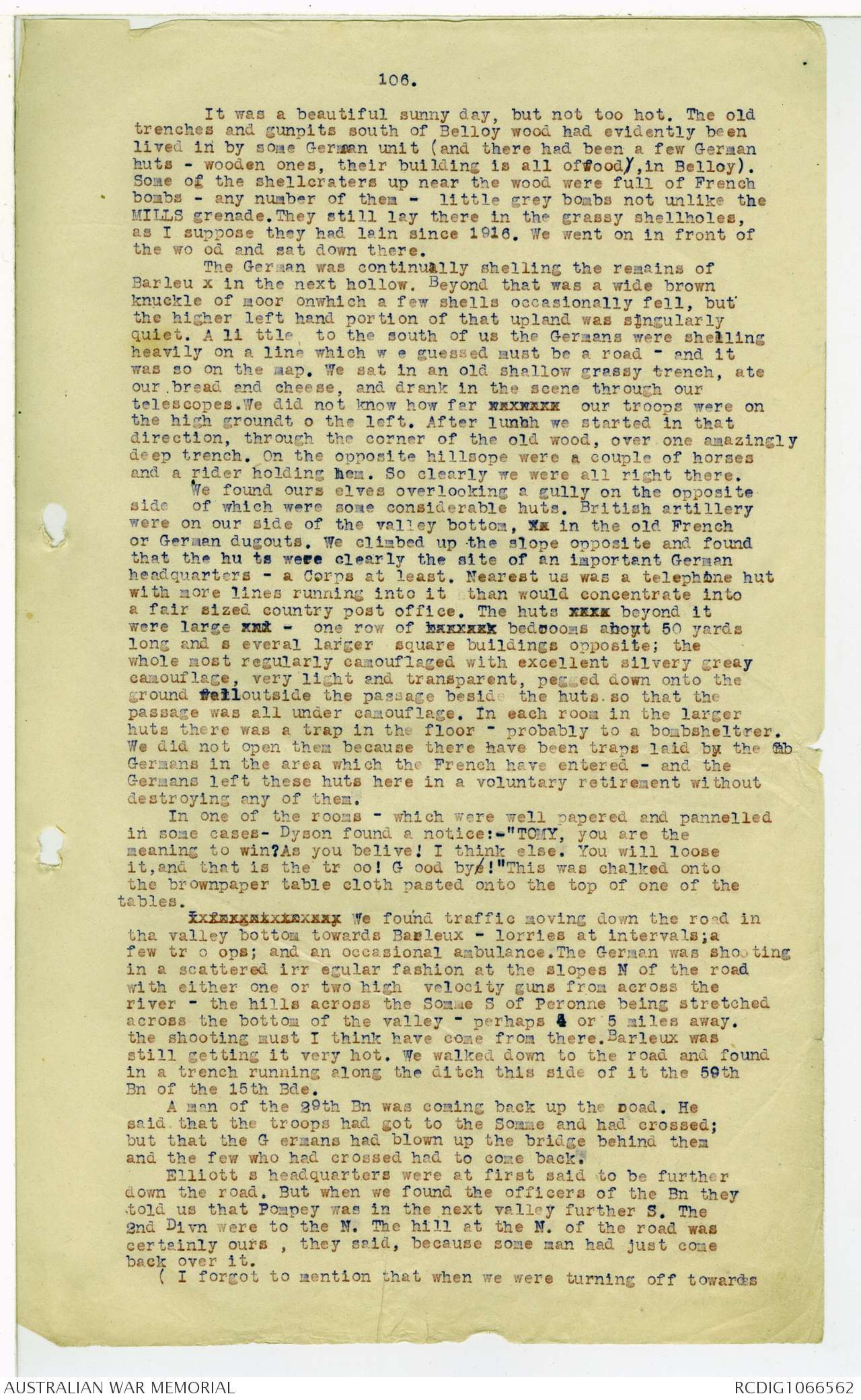
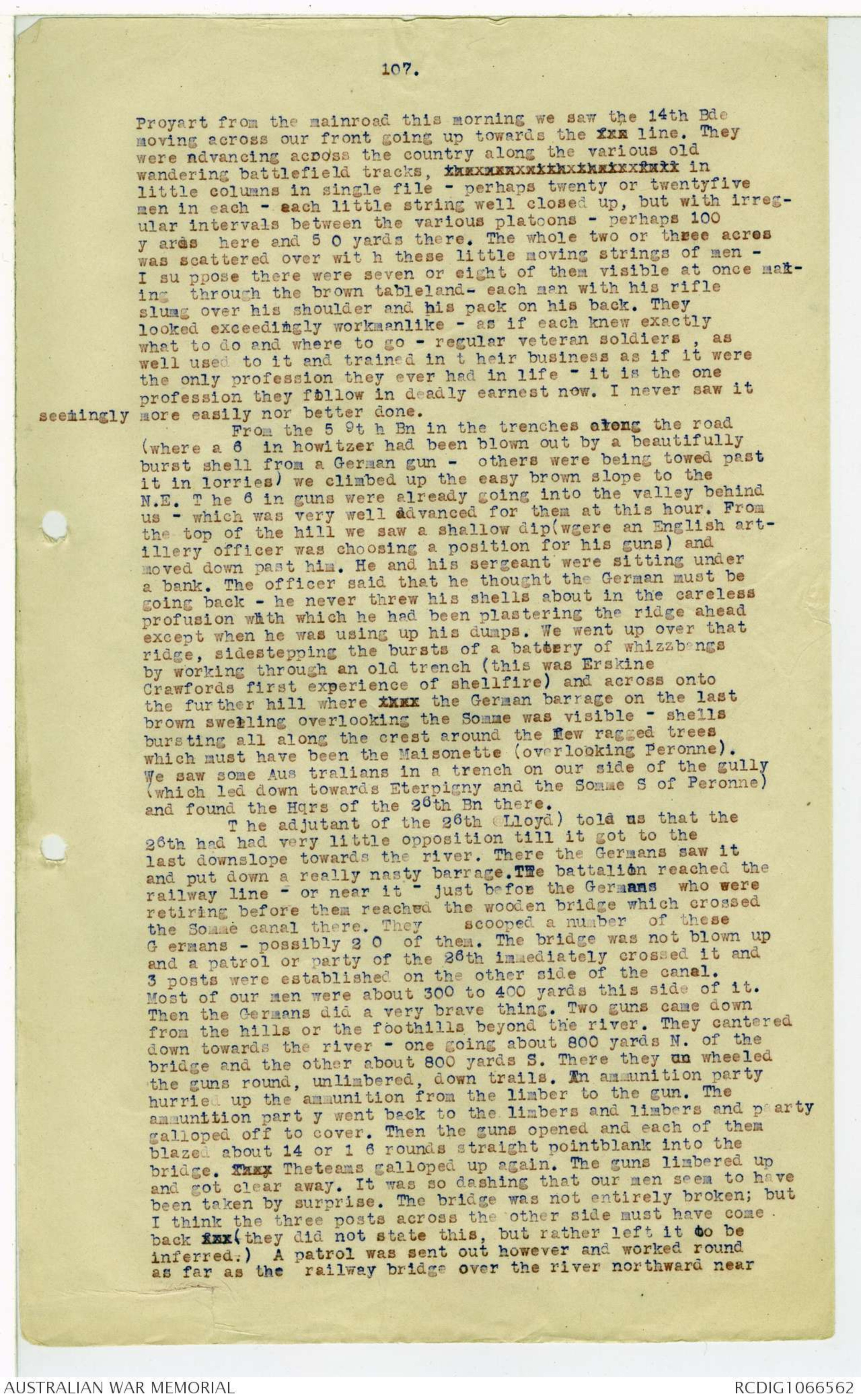
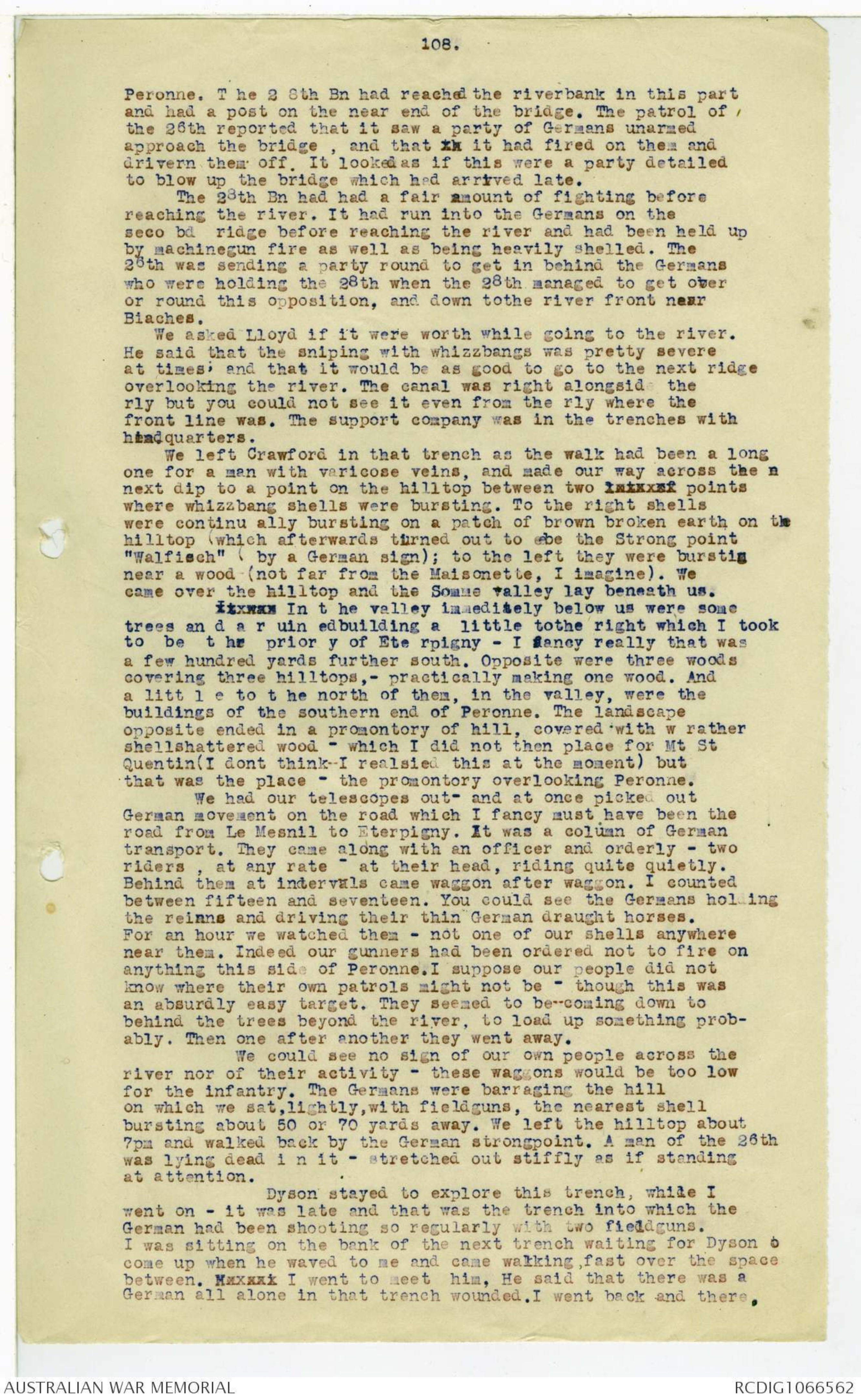
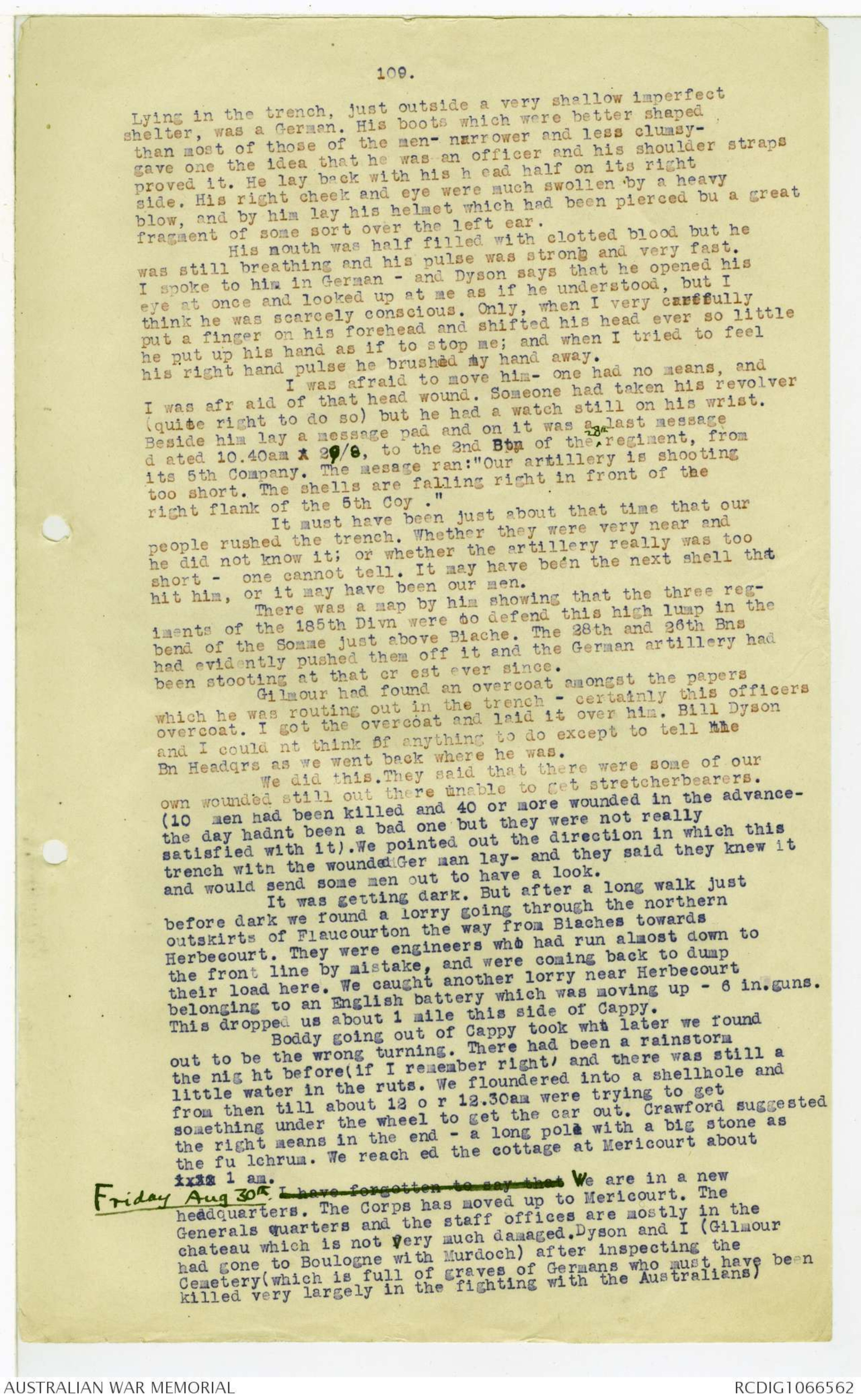
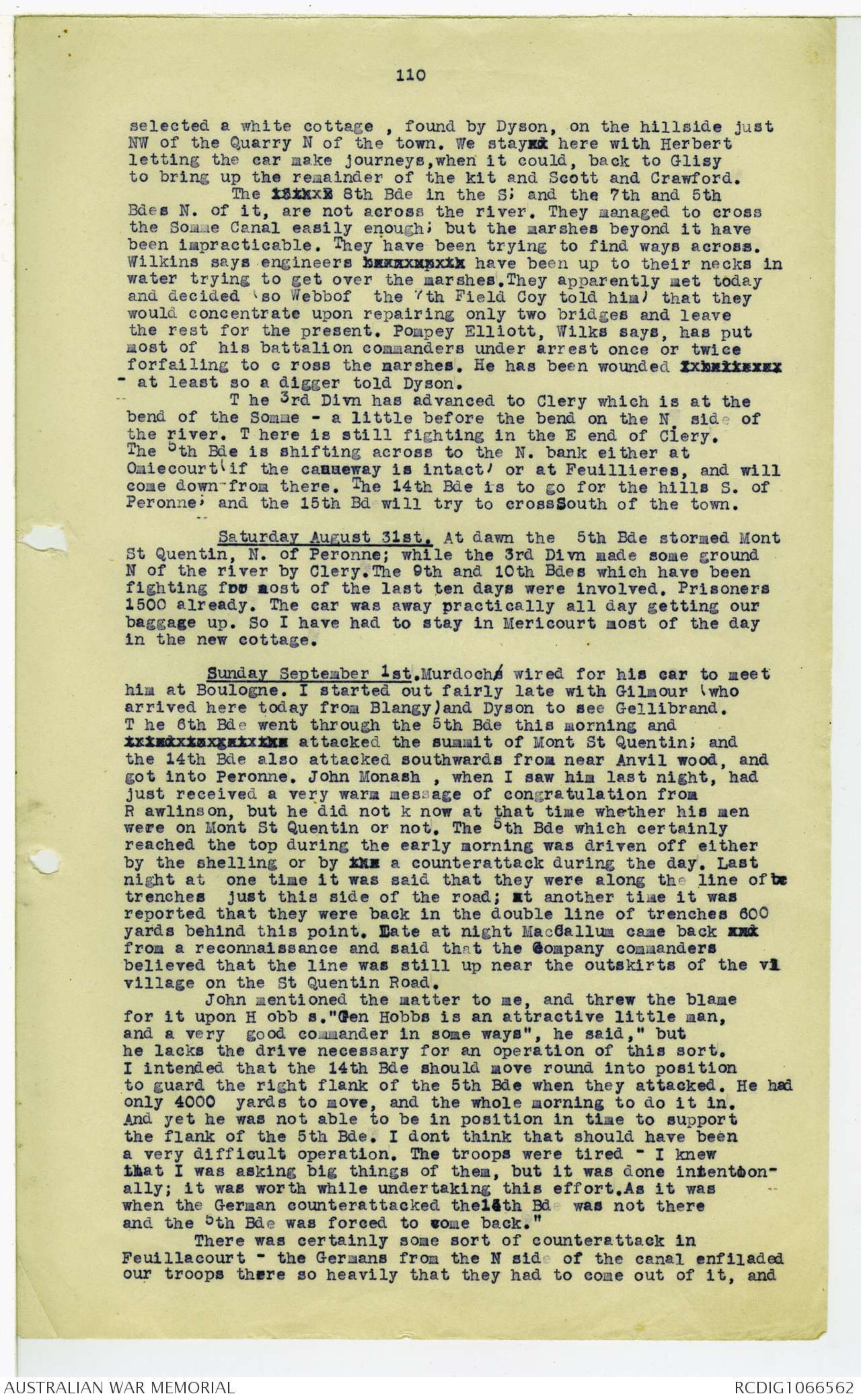
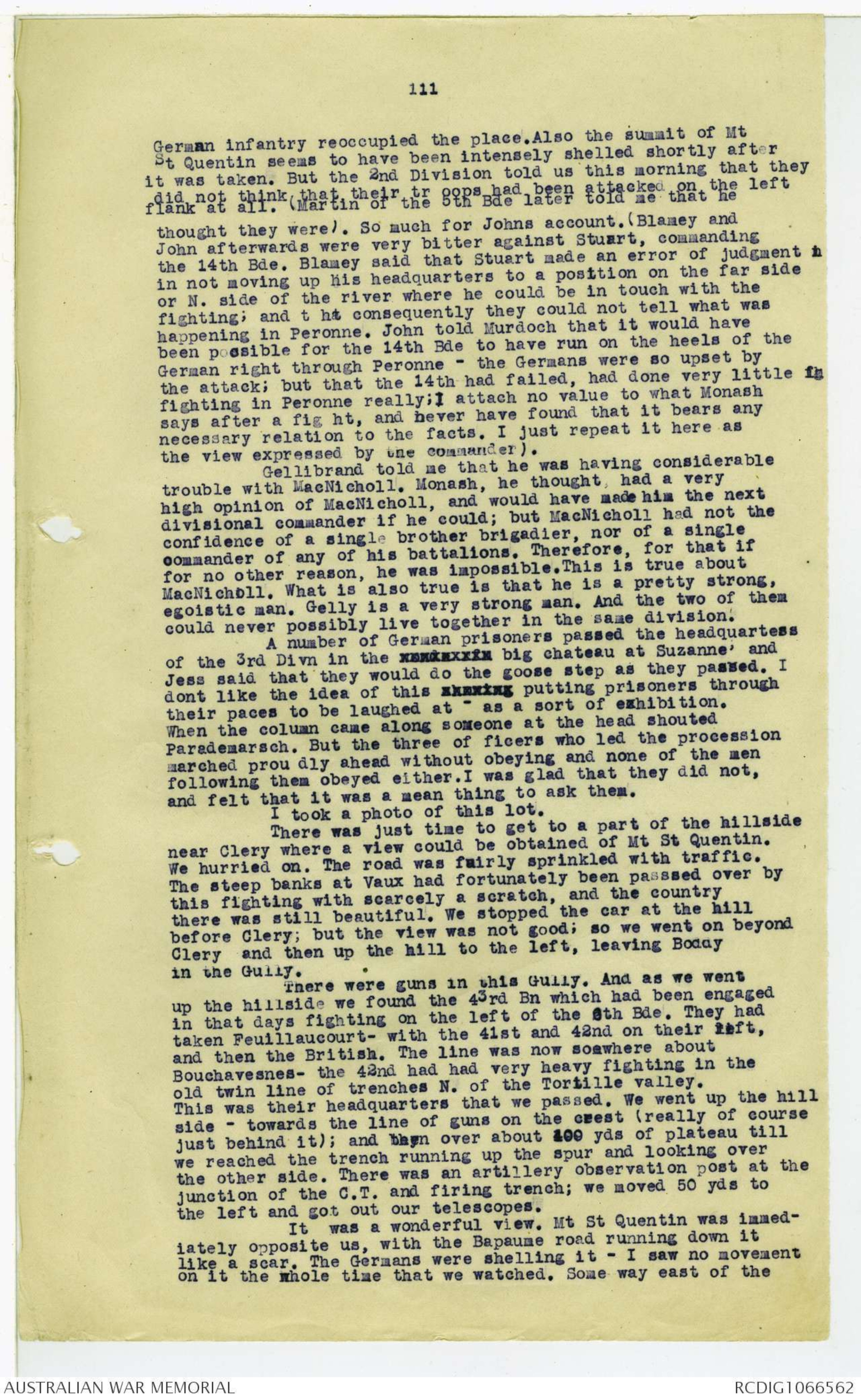
102
(sh ortened, rat h er) almost onto the position where we were.
Of cours e, as I am always inclined to do, we thought that
the Germans had s een us - we could so clearly see them;
and that they had taken us for an Obsercation Post and
w ere sniping. Bu t Dyson said he had seen infantry coming
from the roads behind us, in numbers. We dodged into a xxxxx
deep post leading off the old trench and lay there while he
fired once or twi ce more. T hen the salvoes ceased and we
got up to make our way back. As we got up and started to move,
so didxxxxxx ab out 15 0 British soldiers who were at this
moment coming off the Bapaume road near the Windmill and who
were now, mo ving into the long grass towards us. They came past
in five solid platoons -artillery formation - in file, the five
platoons diamond wise, but not in sections - in whole platoons.
I cleared their front with Murdoch as fast as I could for
these w ere almost certainly what the Germans were sniping
at; I suppos e they had got down into the grass like ourselves-
but now that they had got up to go on again one expected to
see them most unmercifully pasted by that battery at short
range.
T he guns did not fire, however, and the battery I think
m ust have been pu lli ng out. Our guns began to make more
noise - they were shelling in the High Wood direction or
behind it. It was getting dark. The young officer leading
the company told us that his lot (I fancy they must have been
a company and a platoon though they looked more like a
battalion at our pres ent Australian strengths) were being
sent over to push the Germans out of High Wood. It appeared
from what some artillery officers observing from Pozieres
Wi ndmill told Murdoch, that the British had taken High Wood
du ring themorning, but had been put out of it by the Germans
later. A T ommy told us that his lot had been there but
the G ermans gave them a fearful time. We went off down the
main road to the car, a big German gun behind us sending up
an occasional mountainous dustcloud from on or near the
main road at the E end of the place.
A N ew Z ealander told Dyson that they were in Avesnes
and could have taken Bapaume easily; the only thing needed is
a b it of bluff , he said.
Th ere was a big block in Albert, xxxxxxxxx slow to
get through while some divisional transport passed the road
i n front of the c athedral. There were Indians in that
transport - it may have been cavalry. The division with the
dragon for its crest - 37th I fancy - was in this fighting
near Poz ieres
When w e got back I heard that Crawford, my little
friend the playwright, had arrived here to help me with my
clerical work. I sent for him from Egypt to London, and
a sked for him the other day to come over fron there. For
one thing it will give him a chance of seeing the front.
MONDAY AUGUST 26th. Stayed in writing diary, I think
it was thi s day that news arrived of the British (1st Army's)
push up at ARRAS. They put two Canadian and some Scottish
divisions in there -I dont know if there were any English
troops=probablythere were _- and in the first rush, before
dawn, sta rting by moonlight at 3.20, the Canadians had
MONCHY. (I am wri ting this on Aug.30)
I think this day also the weather broke, but am not
certain.
TUESDAY AUGUST 37th. On the Somme our people are now
on the western edge of Eclusier; The 3 rd Divn has got to theE.
edge of Vaux Wood along the river. The 5th Divn (?or 2nd) has
Fontaine les Cappy. If I remember, this day was rather stormy.
I have a note that on Aug. 23rd the 4th Divn advanced its
line by 5 00 yds; that on that day there was stiff fighting
in Chuignolles (where Dyson and Gilmour have found a
103
soldiers home well fitted up). There were 3 Bn Commanders among
the prisoners an d 15 guns besides the 15 inch gun which the
3rd En captured,in Arcy Wood.
On 27th Aug amongst the papers goingthrough the Corps
intel ligence they found xxx a diaryending:-8/8/18. Our morale
has been pretty well finished by the awful artillery fire.
No food and n othing to drink.
14/8/18At Clery. Aer oplanes quite close. Heavy losses.
15/8/18 At Clery. During the night bombs again. The
latest papers arr ive from which we learn the seriousness
of the situation.
Wednesday August 28th. Tonight the 6yh Bde attacked Frise.
at 5.45 they reported that there was sniping from the S end
of Frise; At 6.15 they were mopping up. Some parties of Germans
have been s een running away E of Frise along the Canal.
The Germans are resisting much more stiffly on the high
ground in the north than in the south. On the high ground up
towards the river the resistance is stiff. For that reason the
right is going fast er than the left. (The Germans say that
they retires from Chaulnes and Lihons before the French entered
them- but this is certainly not thecase in the northern part
of our fr ont. Fou caucourt has been very stiffly held. It is
on rising ground wi th a good glacis on all sides and has
certainly been st rongly and deliberately held. Our 3rd Divn
by 11am had reported taking 21 men of the 157th R.I.R. The
Feldwebel said that they had orders to retire fighting. At
noon a report, cam e in that, the French who are on our right
(32nd Divn join them at Marcelpot well ahead of our front)
were already on the SOMME Canal east of Licourt and Morchain
though they had not yet got Morchain. But almost at once a
denial of this came in from the French Corps.
[*?9 Bn
See Vol XII
plate
532*]
The day after the last big attack by us - I
think it was August (24th) [*25th*]- Wilkins went out with a patrol of
the 9th Bde. H e wanted to get a photogrph of a German being
taken prisoner. He has himself taken the surrender of a wounded
German after the troops mopped up at Etinhem - one who pad been
passed over s urrendered to him and Lowe; and once before the xx
same thing happened. He went round Bayonvillers on the morning o
Aug.8th hoping to get a picture of this scene - while the
reoops were mopping up he was with them. But the only prisoner
that party took, coming out of a cellar I think it was, didnt
make a picture to please him- I think the light was too bad.
So he went out this day ahead of the line with a company which
had orders to mop up some dugouts on the road beside the
Canal ah ead of the Company s headquarters, just this side of
Cappy.
Two Lewis gunners were sent out along the left (N) side
of the Canal to fire into the dugout mouths in order to ensure
the Germans being properly frightened beforehand. They fired two
drums of ammunition across the canal (which was almost empty
owing to the Germans having blown up some of the locks or weirs)
and Wilkins took some photographs of the party as it went past
the dugout mouths - the officer leading with a bomb in his hand
which was raised- then the bayonet man - and so one, a little
procession of five or six. But no Germans came out. They went
along to each dugout and whistled down the mouth of it as you mit
might to a dog: "Come on Fritz- now then fritzy-Here Fritz",
and so on. But no Fritz. So they went on, and Wilkins went on
with them. It was not their business - but they went on through
Cappy and a good half mile beyond to a Quarry on one edge of
which the nine of them who were in the little party with
Wilkins and an officer(there were only 40 in the whole company)
set up their gun. Then the Germans appeared. A party of them
rushed up to the other lip of the chalkpit; Wilkins party had
their Lewis gun established on the near side of the xxx pit.
More and more Germans appeared opposite - and their m.gs
became very heavy - Wilkins put his head up beside the Lewis
gun and a Germ an bullet ripped along the other side of the
gun so he kept his head down more after that. The officer with
1 04
then went back to send information to headquarters - I fancy
that by this time our own artillery had begun to bombard
CAPPY in their rear. The party of nine was now in charge of a
sergeant. About 6 German m.gs were firing from various
points ahead of them. The men didnt seem in the least
anxious about being cut off. Our own barrage which had been on
the village began to lift and came towards them, and they had
to decide whether to risk it or the German machinegun. They
resolved that they would risk the machinegun and got low down
under a bank sh eltering them from the rear and too low to
enable the G ermans to see them. T he barrage passed over.
The sergeant was anxious lest the Germans might get a m.g behind
them and so was Wilkins. One of the men had curled up saying
"We're alright. Im going to sleep. Wake me up when the barrage
lifts". However the sergeant decided that it was better to
retire the post. They got out of it by rolling over, one by, one,
till they were down the bank about ten yards and in safety.
One or two men who didnt keep so low were shot, and at least one
of them killed. Wilkins held his camera in his hands over his
head as he rolled. A nd so they got away.
He got no good photographs out in that quarry. The light
was not good or esle there was nothing particular to see. He
had his 5x4 hand camera. The pictures of the patrol going
past the dugouts are interesting.
Monash called a conference of himself, Blamey, Dodds
and xxxxxxxxx myself, to xxxxxxxxxx
discuss the sale of the official photos to the troops, which
is very slow. John wanted it done at the Corps School in
France. I was very opposed to this as it would put the business
under J. and would necessitate our negatives being sent to
three different places. Finally it was agreed that Dodds and
I should see what improvements could be carried out in
London. It means taking out of the hands of Smart, which has
become clearly necessary. They give Smart too muchto do at
Australia House.
Dodds also agreed (as well as Monash) to the scheme
for making our artists ( the official ones) regular member s ff
the A.I.F.I shall have to go over and settle these two things.
Th ursday August 29th. Set out this morning with
Dyson and Gilmour on a joy ride - just to go over the field and
see whatever was interesting.
We started out for the big gun captured by the 3rd
Battalion. We ran up the main road as far as xxxxxxxxxxxxxxxxxx the factory near La Flaque dump- a big German
dump. This was the factory into the chimney of which the tank
accompanying the 31st Bn poured broadside after broadside on
the day of the attack upon Framicourt. The Scotsman in the tank
saw that the left of the line was being held up by this chimney
away on the left - by a mg in it or near it. So he went off am
mile out of his course right across the front and blazed intoit.
Then he came back, and floated round his own battalions front
to see that things were all right and went off home.
We turned left through Proyart and then right at the
entrance of the village and beside a sunken road where the
Germans had been camping and so into a valley - not very wide-
with woods on the hilltops-scattered woods_- and a small wood
on our side of the valley as we turned into it. In the wood,
low down,we at once saw the long barrel of the monster.It
was sticking up only a litt le from the ground. Behind it wasthe
great gun mounting.
It was the mounting which impressed me more than the gun.
It must have been between twenty and thirty feet from top to base.
The Breech of the gun itself had been blown clean away - we found
part of it lying on the hilltop behind the gun - nearly half a mile
away. The gun was on a sort of naval mounting, set deep into
the ground. Behind it was a high platform 7 or 8 feet above the
ground. The gun was given a good big arc - 90 degrees at least
or more. But the only direction in which it had been fired was
towards Amiens. The trees in front of the muzzle in that direction
105.
were blackened and had all the leaves and most of theb
boughs stripped off them. Certainly it must have fired at least
once, and I should say more. Six or seven boxes for the charges
were lying near, empty.
This gun proved more than anything else one had seen
that the Germans intended to stay on this front - possibly
they might have atta cked- the guns does not prove that; but it
does prove that it was part of their plan to use this advanced
position for doing all the damage they could to Amiens and possibly
even ABBEVILLE in order to bring all possible pressure on
the Frenchpeople. The dugouts for the crew were in the bank to
the left. They had not long been made and part of the furniture
of them w as composed of the charge cases for the big gun. Some
of these dugouts have not been finished, only part of the
shaft being du g and not all that lined with the timber sets.
We had heard before we left that the troops had
pushed on pretty fast-they were already through BARLEUX,axxxxxxxxxxtxxxxxxxxxxxxxxxxxxxxxxxxxxFxxxxxxxxx which is very close to PERONNE. So we decided to make
in that direction. We took the car over the hilltop behind the
big gun (where, 5 00 yards away, we found two diggers examining
the breech of the gun which had been thrown there in
the explosion, like a lump of granite on the hilltop) and
so back to the mai nroad. We ran into the mainroad through
Foucaucourt. T ransport of the 1 5th Bde was moving along the
same byeroad - waggons and troops seemed to be streaming
forward by every track. Casey had warne us to look out forn
Flach-minen (instantaneous mines) which the Germans had
buried in various places along the roads and which blew xx
the wheel off a lorry and killed the driver if anything so
heavy went over them. For that reason I didnt want to risk
Boddy over, some of these newly trodden roads too much.
The main road at Foccaucourt was almost a single stting
of traffic - lorries moving along it as well as guns. We
reached the next gully after the Morcourt Gully, and as we wrre
descending the dip in the road there was on the right hand
side a crater about as big as that made by an 8 inch shall,
(8 feet across or 1 0) but shallower. On our side of it was
a gun, detacked from its limber, with a few perforations through
the machinery. On the other side of it was the limber and a
big patch of blood. On the left hand side of the road we had
just passed a few boxes with "Flach-Minen" stencilled on
them. I have no doubt that this gun had struck one of those
mines - a mans weight would not put them up. A little lower
on the left of the road was another exactly similar crater
but no evidence of an accident.
We travelled along this road, the traffice gradually becoming
thinner. T he old Somme battlefield lay like a great
waste moorland on either hand. xxxxx When we left Corps our troops
were reported fighting before Villers Carbonnel, where the
road turnsoffto the left to Peronne. So we turned off
ourselves towards Belloy en Santerre. There were a few waggons
on this road. The Germ ans were shelling the main road where
we should have been had we gone on. At the beginning of the
tumbled mounds which showed where Belloy had been we left the
car. Some art illery were there. We gave a few Anzac Bulletins
to the drivers (the guns were a mile ahead) which they took
as if they were hungry for them (that Australian news gets
only to a few thousand men - Murdoch and Dyson (and I agree)
think that it ought to get to every one); left Boddy with
instructions to go round and meet us in Cappy; and walked on
through the village.
The waggon lines of the 46th Bty were there. Their
officers - two of them - were in an old English Nissen Hut and xx
insisted on our having some tea and a biscuit with them. Then
we walked on through the old grassgrown Somme battlefield
towards the front of Belloy Wood. The horses and waggons of
the batter y were in a slight hollow, the men lying on the ground
beside them.
106.
It was a beautiful sunny day, but not too hot. The old
trenches and gunpits south of Belloy wood had evidently been
lived in by some German unit (and there had been a few German
huts - wooden ones, their building is all ofwood), in Belloy).
Some of the shellcraters up near the wood were full of French
bombs - any number of them - little grey bombs not unlike the
MILLS grenade. They still lay there in the grassy shellholes,
as I suppose they had lain since 1916. We went on in front of
the wo od and sat down there.
The German was continually shelling the remains of
Barleu x in the next hollow. Beyond that was a wide brown
knuckle of moor onwhich a few shells occasionally fell, but
the higher left hand portion of that upland was singularly
quiet. A li ttle, to the south of us the Germans were shelling
heavily on a line which w e guessed must be a road - and it
was so on the map. We sat in an old shallow grassy trench, ate
our bread and cheese, and drank in the scene through our
telescopes.We did not know how far xxxxxxx our troops were on
the high groundt o the left. After lunch we started in that
direction, through the corner of the old wood, over one amazingly
deep trench. On the opposite hillsope were a couple of horses
and a rider holding hem. So clearly we were all right there.
We found ours elves overlooking a gully on the opposite
side of which were some considerable huts. British artillery
were on our side of the valley bottom, xx in the old French
or German dugouts. We climbed up the slope opposite and found
that the hu ts were clearly the site of an important German
headquarters - a Corps at least. Nearest us was a telephone hut
with more lines running into it than would concentrate into
a fair sized country post office. The huts xxxx beyond it
were large xxx - one row of xxxxxxx bedrooms about 50 yards
long and s everal larger square buildings opposite; the
whole most regularly camouflaged with excellent silvery greay
camouflage, very light and transparent, pegged down onto the
ground felloutside the passage beside the huts so that the
passage was all under camouflage. In each room in the larger
huts there was a trap in the floor - probably to a bombsheltrer.
We did not open them because there have been traps laid by the nb
Germans in the area which the French have entered - and the
Germans left these huts here in a voluntary retirement without
destroying any of them.
In one of the rooms - which were well papered and pannelled
in some cases- Dyson found a notice:-"TOMY, you are the
meaning to win?As you belive! I think else. You will loose
it,and that is the tr oo! G ood bye!"This was chalked onto
the brownpaper table cloth pasted onto the top of one of the
tables.xxxxxxxxxxxxxxx We found traffic moving down the road in
the valley bottom towards Barleux - lorries at intervals;a
few tr o ops; and an occasional ambulance.The German was shooting
in a scattered irr egular fashion at the slopes N of the road
with either one or two high velocity guns from across the
river - the hills across the Somme S of Peronne being stretched
across the bottom of the valley - perhaps 4 or 5 miles away.
the shooting must I think have come from there. Barleux was
still getting it very hot. We walked down to the road and found
in a trench running along the ditch this side of it the 59th
Bn of the 15th Bde.
A man of the 29th Bn was coming back up the road. He
said, that the troops had got to the Somme and had crossed;
but that the G ermans had blown up the bridge behind them
and the few who had crossed had to come back.
Elliott s headquarters were at first said to be further
down the road. But when we found the officers of the Bn they
told us that Pompey was in the next valley further S. The
2nd Divn were to the N. The hill at the N. of the road was
certainly ours, they said, because some man had just come
back over it.
( I forgot to mention that when we were turning off towards
107.
Proyart from the mainroad this morning we saw the 14th Bde
moving across our front going up towards the xxx line. They
were ndvancing across the country along the various old
wandering battlefield tracks, xxxxxxxxxxxx in
little columns in single file - perhaps twenty or twentyfive
men in each - each little string well closed up, but with irregular
intervals between the various platoons - perhaps 100
y ards, here and 5 0 yards there. The whole two or three acres
was scattered over wit h these little moving strings of men -
I su ppose there were seven or eight of them visible at once making
through the brown tableland- each man with his rifle
slung over his shoulder and his pack on his back. They
looked exceedingly workmanlike - as if each knew exactly
what to do and where to go - regular veteran soldiers , as
well used to it and trained in t heir business as if it were
the only profession they ever had in life - it is the one
profession they follow in deadly earnest now. I never saw it
seemingly more easily nor better done.
From the 5 9t h Bn in the trenches along the road
(where a 6 in howitzer had been blown out by a beautifully
burst shell from a German gun - others were being towed past
it in lorries) we climbed up the easy brown slope to the
N.E. T he 6 in guns were already going into the valley behind
us - which was very well advanced for them at this hour. From
the top of the hill we saw a shallow dip(wgere an English artillery
officer was choosing a position for his guns) and
moved down past him. He and his sergeant were sitting under
a bank. The officer said that he thought the German must be
going back - he never threw his shells about in the careless
profusion with which he had been plastering the ridge ahead
except when he was using up his dumps. We went up over that
ridge, sidestepping the bursts of a battery of whizzbangs
by working through an old trench (this was Erskine
Crawfords first experience of shellfire) and across onto
the further hill where xxxx the German barrage on the last
brown swelling overlooking the Somme was visible - shells
bursting all along the crest around the few ragged trees
which must have been the Maisonette (overlooking Peronne).
We saw some Aus tralians in a trench on our side of the gully
(which led down towards Eterpigny and the Somme S of Peronne)
and found the Hqrs of the 26th Bn there.
The adjutant of the 26th (Lloyd) told us that the
26th had had very little opposition till it got to the
last downslope towards the river. There the Germans saw it
and put down a really nasty barrage. The battalion reached the
railway line - or near it - just before the Germans who were
retiring before them reached the wooden bridge which crossed
the Somme canal there. They scooped a number of these
G ermans - possibly 2 0 of them. The bridge was not blown up
and a patrol or party of the 26th immediately crossed it and
3 posts were established on the other side of the canal.
Most of our men were about 300 to 400 yards this side of it.
Then the Germans did a very brave thing. Two guns came down
from the hills or the foothills beyond the river. They cantered
down towards the river - one going about 800 yards N. of the
bridge and the other about 800 yards S. There they un wheeled
the guns round, unlimbered, down trails. An ammunition party
hurried up the ammunition from the limber to the gun. The
ammunition part y went back to the limbers and limbers and p arty
galloped off to cover. Then the guns opened and each of them
blazed about 14 or 1 6 rounds straight pointblank into the
bridge. xxxx Theteams galloped up again. The guns limbered up
and got clear away. It was so dashing that our men seem to have
been taken by surprise. The bridge was not entirely broken; but
I think the three posts across the other side must have come
back xxx(they did not state this, but rather left it to be
inferred.) A patrol was sent out however and worked round
as far as the railway bridge over the river northward near
108.
Peronne. T he 2 8th Bn had reached the riverbank in this part
and had a post on the near end of the bridge. The patrol of
the 26th reported that it saw a party of Germans unarmed
approach the bridge, and that xx it had fired on them and
drivern them off. It looked as if this were a party detailed
to blow up the bridge which had arrived late.
The 28th Bn had had a fair amount of fighting before
reaching the river. It had run into the Germans on the
seco bd ridge before reaching the river and had been held up
by machinegun fire as well as being heavily shelled. The
26th was sending a party round to get in behind the Germans
who were holding the 28th when the 28th managed to get over
or round this opposition, and down tothe river front near
Biaches.
We asked Lloyd if it were worth while going to the river.
He said that the sniping with whizzbangs was pretty severe
at times; and that it would be as good to go to the next ridge
overlooking the river. The canal was right alongside the
rly but you could not see it even from the rly where the
front line was. The support company was in the trenches with
headquarters.
We left Crawford in that trench as the walk had been a long
one for a man with varicose veins, and made our way across the n
next dip to a point on the hilltop between two xxxxxxx points
where whizzbang shells were bursting. To the right shells
were continu ally bursting on a patch of brown broken earth on the
hilltop (which afterwards turned out to be the Strong point
"Walfisch" (by a German sign); to the left they were burstig
near a wood (not far from the Maisonette, I imagine). We
came over the hilltop and the Somme valley lay beneath us.xxxxxx In t he valley immeditely below us were some
trees and a r uin edbuilding a little tothe right which I took
to be t he prior y of Ete rpigny - I fancy really that was
a few hundred yards further south. Opposite were three woods
covering three hilltops,- practically making one wood. And
a litt le tot he north of them, in the valley, were the
buildings of the southern end of Peronne. The landscape
opposite ended in a promontory of hill, covered with w rather
shellshattered wood - which I did not then place for Mt St
Quentin (I dont think-I realsied this at the moment) but
that was the place - the promontory overlooking Peronne.
We had our telescopes out- and at once picked out
German movement on the road which I fancy must have been the
road from Le Mesnil to Eterpigny. It was a column of German
transport. They came along with an officer and orderly - two
riders , at any rate - at their head, riding quite quietly.
Behind them at intervals came waggon after waggon. I counted
between fifteen and seventeen. You could see the Germans holding
the reinns and driving their thin German draught horses.
For an hour we watched them - not one of our shells anywhere
near them. Indeed our gunners had been ordered not to fire on
this side of Peronne.I suppose our people did not
know where their own patrols might not be - though this was
an absurdly easy target. They seemed to be-coming down to
behind the trees beyond the river, to load up something probably.
Then one after another they went away.
We could see no sign of our own people across the
river nor of their activity - these waggons would be too low
for the infantry. The Germans were barraging the hill
on which we sat,lightly, with fieldguns, the nearest shell
bursting about 50 or 70 yards away. We left the hilltop about
7pm and walked back by the German strongpoint. A man of the 26th
was lying dead i n it - stretched out stiffly as if standing
at attention.
Dyson stayed to explore this trench, while I
went on - it was late and that was the trench into which the
German had been shooting so regularly with two fieldguns.
I was sitting on the bank of the next trench waiting for Dyson o
come up when he waved to me and came walking,fast over the space
between. xxxxI went to meet him, He said that there was a
German all alone in that trench wounded.I went back and there,
109.
Lying in the trench, just outside a very shallow imperfect
shelter, was a German. His boots which were better shaped
than most of those of the men- narrower and less clumsy-
gave one the idea that he was an officer and his shoulder straps
proved it. He lay back with his h ead half on its right
side. His right cheek and eye were much swollen by a heavy
blow, and by him lay his helmet which had been pierced bu a great
fragment of some sort over the left ear.
His mouth was half filled with clotted blood but he
was still breathing and his pulse was strong and very fast.
I spoke to him in German - and Dyson says that he opened his
eye at once and looked up at me as if he understood, but I
think he was scarcely conscious. Only, when I very carefully
put a finger on his forehead and shifted his head ever so little
he put up his hand as if to stop me; and when I tried to feel
his right hand pulse he brushed my hand away.
I was afraid to move him- one had no means, and
I was afr aid of that head wound. Someone had taken his revolver
(quite right to do so) but he had a watch still on his wrist.
Beside him lay a message pad and on it was a last message
d ated 10.40am x [[20/8?]], to the 2nd Btn of the ∧28th regiment, from
its 5th Company. The mesage ran:"Our artillery is shooting
too short. The shells are falling right in front of the
right flank of the 5th Coy."
It must have been just about that time that our
people rushed the trench. Whether they were very near and
he did not know it; or whether the artillery really was too
short - one cannot tell. It may have beén the next shell that
hit him, or it may have been our men.
There was a map by him showing that the three regiments
of the 185th Divn were to defend this high lump in the
bend of the Somme just above Biache. The 28th and 26th Bns
had evidently pushed them off it and the German artillery had
been stooting at that cr est ever since.
Gilmour had found an overcoat amongst the papers
which he was routing out in the trench - certainly this officers
overcoat. I got the overcoat and laid it over him. Bill Dyson
and I could nt think of anything to do except to tell the
Bn Headqrs as we went back where he was.
We did this. They said that there were some of our
own wounded still out there unable to get stretcherbearers.
(10 men had been killed and 40 or more wounded in the advance-
the day hadnt been a bad one but they were not really
satisfied with it).We pointed out the direction in which this
trench with the woundedGer man lay- and they said they knew it
and would send some men out to have a look.
It was getting dark. But after a long walk just
before dark we found a lorry going through the northern
outskirts of Flaucourton the way from Biaches towards
Herbecourt. They were engineers who had run almost down to
the front line by mistake, and were coming back to dump
their load here. We caught another lorry near Herbecourt
belonging to an English battery which was moving up - 6 in.guns.
This dropped us about 1 mile this side of Cappy.
Boddy going out of Cappy took wht later we found
out to be the wrong turning. There had been a rainstorm
the nig ht before(if I remember right) and there was still a
little water in the ruts. We floundered into a shellhole and
from then till about 12 o r 12.30am were trying to get
something under the wheel to get the car out. Crawford suggested
the right means in the end - a long pole with a big stone as
the fu lchrum. We reach ed the cottage at Mericourt aboutxxxx 1 am.
Friday Au 30th I have forgotten to say that We are in a new
headquarters. The Corps has moved up to Mericourt. The
Generals quarters and the staff offices are mostly in the
chateau which is not very much damaged.Dyson and I (Gilmour
had gone to Boulogne with Murdoch) after inspecting the
Cemetery(which is full of graves of Germans who must have been
killed very largely in the fighting with the Australians)
110
selected a white cottage , found by Dyson, on the hillside just
NW of the Quarry N of the town. We stayxx here with Herbert
letting the car make journeys,when it could, back to Glisy
to bring up the remainder of the kit and Scott and Crawford.
The xxxxxx 8th Bde in the S; and the 7th and 5th
Bdes N. of it, are not across the river. They managed to cross
the Somme Canal easily enough; but the marshes beyond it have
been impracticable. They have been trying to find ways across.
Wilkins says engineers xxxxxxxxxx have been up to their necks in
water trying to get over the marshes.They apparently met today
and decided (so Webbof the 7th Field Coy told him) that they
would concentrate upon repairing only two bridges and leave
the rest for the present. Pompey Elliott, Wilks says, has put
most of his battalion commanders under arrest once or twice
forfailing to c ross the narshes. He has been wounded xxxxxxxxxx
- at least so a digger told Dyson.
T he 3rd Divn has advanced to Clery which is at the
bend of the Somme - a little before the bend on the N side of
the river. T here is still fighting in the E end of Clery.
The 5th Bde is shifting across to the N. bank either at
Omiecourt(if the cauueway is intact) or at Feuillieres, and will
come down from there. The 14th Bde is to go for the hills S. of
Peronne; and the 15th Bd will try to crossSouth of the town.
Saturday August 31st. At dawn the 5th Bde stormed Mont
St Quentin, N. of Peronne; while the 3rd Divn made some ground
N of the river by Clery.The 9th and 10th Bdes which have been
fighting foo most of the last ten days were involved. Prisoners
1500 already. The car was away practically all day getting our
baggage up. So I have had to stay in Mericourt most of the day
in the new cottage.
Sunday September 1st. Murdochs wired for his car to meet
him at Boulogne. I started out fairly late with Gilmour (who
arrived here today from Blangy) and Dyson to see Gellibrand.
The 6th Bde went through the 5th Bde this morning and
xxxxxxxxxxxxxxxx attacked the summit of Mont St Quentin; and
the 14th Bde also attacked southwards from near Anvil wood, and
got into Peronne. John Monash , when I saw him last night, had
just received a very warm message of congratulation from
R awlinson, but he did not k now at that time whether his men
were on Mont St Quentin or not. The 5th Bde which certainly
reached the top during the early morning was driven off either
by the shelling or by xxx a counterattack during the day. Last
night at one time it was said that they were along the line of be
trenches just this side of the road; at another time it was
reported that they were back in the double line of trenches 600
yards behind this point. Late at night MacCallum came back xxx
from a reconnaissance and said that the Company commanders
believed that the line was still up near the outskirts of the vi
village on the St Quentin Road.
John mentioned the matter to me, and threw the blame
for it upon Hobb s."Gen Hobbs is an attractive little man,
and a very good commander in some ways", he said," but
he lacks the drive necessary for an operation of this sort.
I intended that the 14th Bde should move round into position
to guard the right flank of the 5th Bde when they attacked. He had
only 4000 yards to move, and the whole morning to do it in.
And yet he was not able to be in position in time to support
the flank of the 5th Bde. I dont think that should have been
a very difficult operation. The troops were tired - I knew
that I was asking big things of them, but it was done intentionally;
it was worth while undertaking this effort.As it was
when the German counterattacked the15th Bde was not there
and the 5th Bde was forced to come back."
There was certainly some sort of counterattack in
Feuillacourt - the Germans from the N side of the canal enfiladed
our troops there so heavily that they had to come out of it, and
111
German infantry reoccupied the place.Also the summit of Mt
St Quentin seems to have been intensely shelled shortly after
it was taken. But the 2nd Division told us this morning that they
did not think that their tr oops had been attacked on, the left
flank at all. (Martin of the 5th Bde later told me that he
thought they were). So much for Johns account.(Blamey and
John afterwards were very bitter against Stuart, commanding
the 14th Bde. Blamey said that Stuart made an error of judgment n
in not moving up his headquarters to a position on the far side
or N. side of the river where he could be in touch with the
fighting; and t ht consequently they could not tell what was
happening in Peronne. John told Murdoch that it would have
been possible for the 14th Bde to have run on the heels of the
German right through Peronne - the Germans were so upset by
the attack; but that the 14th had failed, had done very little fn
fighting in Peronne really;I attach no value to what Monash
says after a fig ht, and never have found that it bears any
necessary relation to the facts. I just repeat it here as
the view expressed by the commander).
Gellibrand told me that he was having considerable
trouble with MacNicholl. Monash, he thought, had a very
high opinion of MacNicholl, and would have made him the next
divisional commander if he could; but MacNicholl had not the
confidence of a single brother brigadier, nor of a single
commander of any of his battalions. Therefore, for that if
for no other reason, he was impossible.This is true about
MacNicholl. What is also true is that he is a pretty strong,
egoistic man. Gelly is a very strong man. And the two of them
could never possibly live together in the same division.
A number of German prisoners passed the headquarters
of the 3rd Divn in the xxxxxxxxx big chateau at Suzanne' and
Jess said that they would do the goose step as they passed. I
dont like the idea of this xxxxxxx putting prisoners through
their paces to be laughed at - as a sort of exhibition.
When the column came along someone at the head shouted
Parademarsch. But the three of ficers who led the procession
marched prou dly ahead without obeying and none of the men
following them obeyed either.I was glad that they did not,
and felt that it was a mean thing to ask them.
I took a photo of this lot.
There was just time to get to a part of the hillside
near Clery where a view could be obtained of Mt St Quentin.
We hurried on. The road was fairly sprinkled with traffic.
The steep banks at Vaux had fortunately been passsed over by
this fighting with scarcely a scratch, and the country
there was still beautiful. We stopped the car at the hill
before Clery; but the view was not good; so we went on beyond
Clery and then up the hill to the left, leaving Boddy
in the Gully.
There were guns in this Gully. And as we went
up the hillside we found the 43rd Bn which had been engaged
in that days fighting on the left of the 6th Bde. They had
taken Feuillaucourt- with the 41st and 42nd on their left,
and then the British. The line was now soewhere about
Bouchavesnes- the 42nd had had very heavy fighting in the
old twin line of trenches N. of the Tortille valley.
This was their headquarters that we passed. We went up the hill
side - towards the line of guns on the crest (really of course
just behind it); and then over about 100 yds of plateau till
we reached the trench running up the spur and looking over
the other side. There was an artillery observation post at the
junction of the C.T. and firing trench; we moved 50 yds to
the left and got out our telescopes.
It was a wonderful view. Mt St Quentin was immediately
opposite us, with the Bapaume road running down it
like a scar. The Germans were shelling it - I saw no movement
on it the whole tine that we watched. Some way east of the
 Deb Parkinson
Deb ParkinsonThis transcription item is now locked to you for editing. To release the lock either Save your changes or Cancel.
This lock will be automatically released after 60 minutes of inactivity.